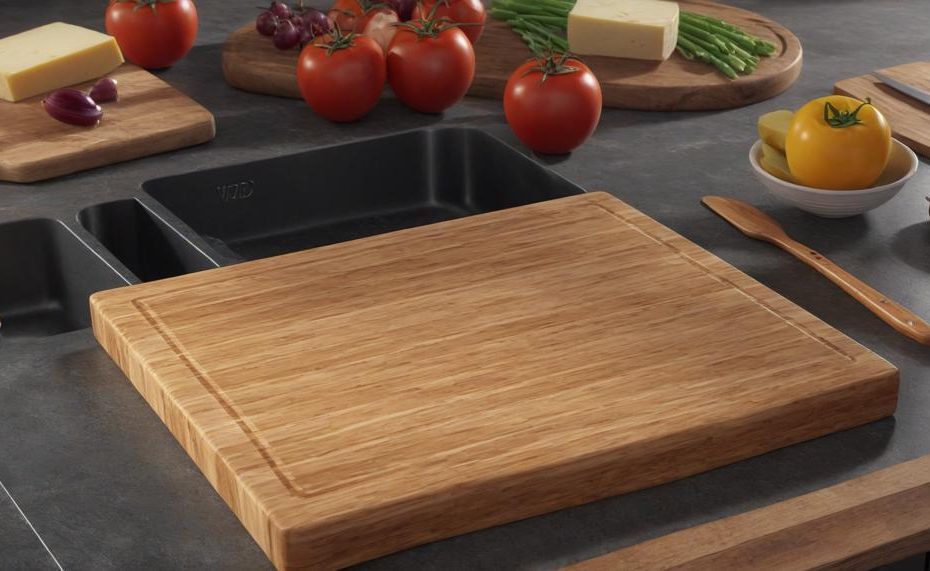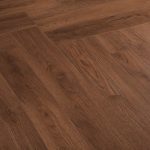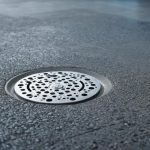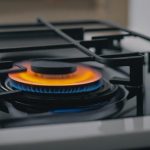Keeping your kitchen safe starts with proper hygiene, and cleaning your wood cutting board after using it for raw chicken is a crucial step in preventing bacterial contamination. Wood cutting boards are beautiful and durable, but they are also porous, making them susceptible to absorbing harmful bacteria from raw meat. If not cleaned thoroughly, these bacteria can multiply and pose a serious health risk.
Here’s a quick rundown of key steps to ensure your wood cutting board stays clean and safe:
- Immediate Rinse: As soon as you’re done, rinse the cutting board with hot water to remove chicken juices.
- Hand Wash with Hot Soapy Water: Use dish soap and hot water to scrub the board, paying special attention to any grooves or knife marks.
- Deep Clean with Vinegar and Hydrogen Peroxide: Spray undiluted white distilled vinegar on the board and let it sit for 5 minutes, then rinse. Follow with 3-percent hydrogen peroxide, let it sit for another 5 minutes, then rinse again with hot water.
- Designate a Specific Board: Use a specific cutting board for raw meat to avoid cross-contamination.
- Inspect Regularly: Check your cutting board for cracks or deep grooves where bacteria can hide and replace or repair it if necessary.
By following these steps, you can ensure that your wood cutting board remains a safe tool in your kitchen, ready for its next culinary challenge. Dive into these tips and make your kitchen a haven of cleanliness and delicious creations.
Contents
- 1 How Often to Clean a Wooden Cutting Board
- 2 Considerations Before You Get Started
- 3 How to Clean a Wooden Cutting Board With Dishwashing Liquid
- 4 How to Clean a Wooden Cutting Board With Bleach
- 5 How to Clean a Wooden Cutting Board With Lemon
- 6 How to Keep Your Wooden Cutting Board Clean Longer
- 7 Conclusion
How Often to Clean a Wooden Cutting Board
Clean your wooden cutting board immediately after each use, especially when cutting raw chicken. This prevents bacterial contamination and keeps your board safe for future use.
| Step | Action | Frequency |
| Rinse | Rinse with hot water immediately after use | Every use |
| Scrub | Scrub with hot water and dish soap | Every use |
| Disinfect | Apply vinegar and hydrogen peroxide, let sit, then rinse | Every use after raw chicken |
| Dry | Dry completely with a clean towel | Every use |
| Deep Clean | Disinfect with bleach solution | Monthly |
By adhering to these practices, you’ll ensure your wooden cutting board remains safe and hygienic, ready for all your culinary creations.
Considerations Before You Get Started
Before cleaning a wooden cutting board used for raw chicken, it’s critical to consider several factors to ensure thorough sanitation and maintain the board’s condition. Here’s a detailed look:
| Factor | Details | Additional Tips |
| Cleaning Materials | Gather all necessary cleaning supplies before you begin. Essential items include dish soap, warm water, baking soda, distilled white vinegar, and a scrub brush. | Using an ISSA-certified cleaning technician recommended soap can enhance effectiveness. |
| Sanitizing Agents | Use effective sanitizing agents like distilled white vinegar or 3 percent hydrogen peroxide to kill bacteria like salmonella and E. coli. | After applying vinegar or peroxide, let it sit for a few minutes before rinsing to maximize bacteria elimination. |
| Gentle Products | Avoid harsh chemicals that can damage the wood. Stick to gentle products like dish soap and natural disinfectants. | Baking soda is excellent for removing stains without harming the wood. Mix with water to form a paste for stubborn spots. |
| Water Temperature | Use warm, not hot water to clean the board. Hot water can warp or crack the wood over time. | Rinse thoroughly to ensure no soap residue is left, which can affect the wood’s integrity. |
| Drying Process | After cleaning, dry the board immediately with a clean towel. Leaving it wet can lead to warping or mold growth. | Stand the board upright to allow even air drying, preventing moisture buildup. |
| Inspection for Wear | Regularly inspect the board for cracks or deep cuts where bacteria can hide. Replace or repair if necessary. | Monthly deep cleaning helps maintain the board’s condition and ensures longevity. |
To maintain a safe and hygienic kitchen, these factors are crucial.
How to Clean a Wooden Cutting Board With Dishwashing Liquid
The best way to clean a wooden cutting board after it has been used to cut raw chicken involves a detailed process to ensure all bacteria are eliminated and the board is safe for future use.
Rinse Immediately
Rinse the cutting board with hot water to remove any raw chicken residue. This prevents the juices from soaking into the wood and helps start the cleaning process.
Wash with Dishwashing Liquid
Use a mild dish soap and a soft sponge. Create a soapy solution with warm water and scrub the board thoroughly on both sides, even if only one side was used. Avoid abrasive scouring pads to prevent damaging the wood’s surface.
Disinfect
After washing, disinfect the board to kill any remaining bacteria. There are several effective methods:
| Method | Materials | Instructions |
| White Vinegar | Undiluted white vinegar | Spray or pour the vinegar onto the board, let it sit for 5 minutes, then rinse with hot water. |
| Hydrogen Peroxide | 3% hydrogen peroxide | Spray the hydrogen peroxide onto the board, let it sit for 5 minutes, then rinse with hot water. |
| Baking Soda Paste | Baking soda, water | Make a paste with baking soda and water, scrub the board, rinse with hot water. |
Dry Thoroughly
Use a clean cloth or paper towel to dry the cutting board thoroughly. Stand it upright or place it in a well-ventilated area to air dry completely. This step is crucial to prevent moisture from remaining in the wood, which can harbor bacteria.
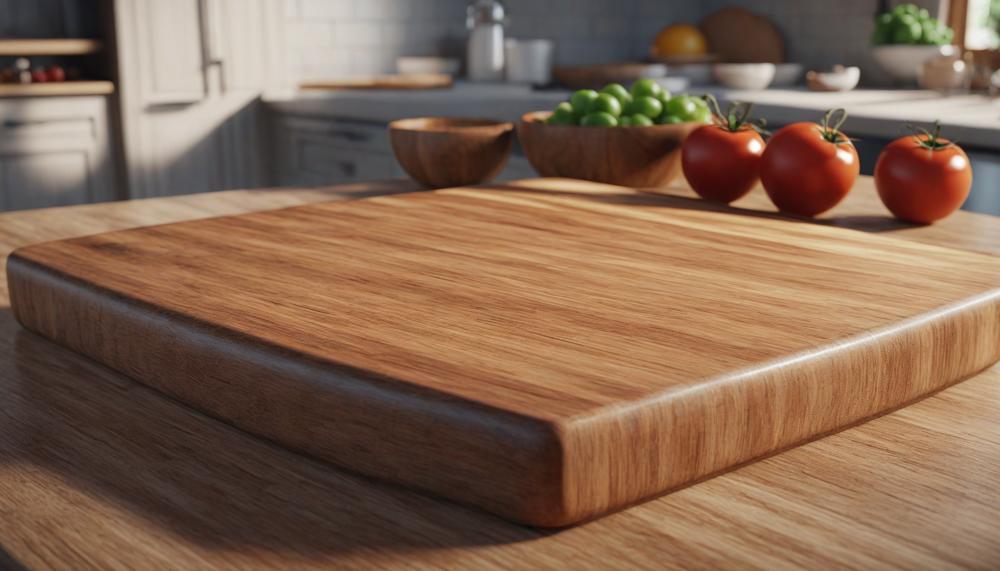
Maintain Regularly
Regular maintenance ensures your cutting board stays in good condition:
- Oiling: Periodically, apply mineral oil to keep the wood from drying out and to create a protective barrier.
- Inspect for Wear: Check for deep grooves or cracks and replace or repair as needed to prevent bacteria from hiding in damaged areas.
How to Clean a Wooden Cutting Board With Bleach
| Step | Description | Tips |
| Rinse Immediately | Rinse the board with hot running water to remove chicken residue. | Prevents bacteria from settling into the wood’s pores. |
| Wash with Hot Water and Soap | Scrub with hot water and dish soap, using a stiff brush. | Pay attention to knife grooves and scratches. |
| Sanitize with Bleach Solution | Mix 1 tbsp of bleach per gallon of water, apply, and let sit for 2 minutes. Rinse thoroughly. | Ensures all bacteria are killed. |
| Dry Completely | Pat dry with a clean towel and air dry upright. | Prevents mould and bacterial growth. |
| Regular Maintenance | Monthly deep clean with vinegar or hydrogen peroxide and oil periodically. | Keeps the board in good condition and bacteria-free. |
Pro Tip: Designate separate cutting boards for raw meat and other foods to prevent cross-contamination. Always inspect your board for deep cuts and grooves; replace it if it becomes too worn, as these can harbour harmful bacteria.
How to Clean a Wooden Cutting Board With Lemon
To clean a wooden cutting board effectively after handling raw chicken, follow these detailed steps using lemon:
Initial Rinse
Immediately after use, rinse the cutting board with hot water to remove any raw chicken residue. This step prevents bacteria from soaking into the wood.
Salt Application
Sprinkle a generous amount of coarse salt over the wet cutting board. Salt acts as an abrasive agent that helps scrub away any lingering bacteria and debris.
Lemon Scrub
Cut a lemon in half and squeeze the juice over the salted board. Use the lemon halves to scrub the surface vigorously. The acidity of the lemon juice helps kill bacteria, while the salt aids in the scrubbing process.
Deep Clean
For an even deeper clean, sprinkle baking soda over the board before using the lemon. Baking soda helps to neutralize odors and further sanitizes the board.
Let Sit
Allow the lemon and salt mixture to sit on the board for about 5 minutes. This waiting period ensures that the natural disinfecting properties of the lemon can take effect.
Final Rinse
Rinse the board thoroughly with hot water to wash away the lemon juice, salt, and any loosened debris. Ensure no residue remains, as it could affect the taste of future food prepared on the board.
Drying
Pat the board dry with a clean cloth and let it air dry completely in an upright position. This prevents moisture from becoming trapped, which can lead to warping and bacterial growth.
Monthly Maintenance
Give your board a “spa treatment” once a month by repeating this process, ensuring it stays fresh and clean. This practice extends the life of your cutting board and keeps it sanitary.
How to Keep Your Wooden Cutting Board Clean Longer
Maintaining the cleanliness of a wooden cutting board after using it for raw chicken requires diligent care to prevent bacterial growth and prolong its lifespan. Here’s a detailed guide:
| Step | Action | Explanation |
| Immediate Rinse | Rinse the board under hot running water immediately after use. | This prevents raw chicken juices from soaking into the wood and reduces the risk of bacteria. |
| Cleaning | Wash with hot water and a mild dish soap using a scrub brush. | Scrubbing removes residues and soap helps break down fats and proteins from the raw chicken. |
| Sanitizing | Use a solution of one tablespoon of bleach in one gallon of water. | Soak a cloth in the solution and wipe the board generously, allowing it to stand for one minute before rinsing. |
| Vinegar and Peroxide | Spray undiluted white vinegar, followed by 3-percent hydrogen peroxide. | Let each sit for 5 minutes to deeply sanitize. Rinse thoroughly afterward. |
| Drying | Pat dry with a clean towel and let it air-dry upright. | Ensure the board is completely dry to prevent bacterial growth in the wood. |
| Oiling | Apply food-grade mineral oil once a month. | This helps seal the wood, making it less porous and extending its life. |
| Designation | Use separate boards for raw meat and other foods. | Prevents cross-contamination, which is crucial for maintaining hygiene. |
| Inspection | Regularly inspect and replace boards with deep cuts or grooves. | Cracks and grooves can harbor bacteria, making thorough cleaning difficult. |
Following these steps ensures that your wooden cutting board remains hygienic and durable. For more detailed guidelines, consider reviewing resources from trusted culinary websites or food safety authorities.
Conclusion
Ensuring your wood cutting board is properly cleaned after cutting raw chicken is vital for maintaining kitchen hygiene. Wood cutting boards, while aesthetically pleasing and durable, can absorb harmful bacteria due to their porous nature. To keep your board safe, follow these steps:
First, rinse the board with hot water immediately after use to remove any raw chicken juices. Next, wash it thoroughly with hot, soapy water, scrubbing all surfaces to ensure thorough cleaning. For deeper disinfection, spray undiluted white vinegar on the board and let it sit for 5 minutes, then rinse. Follow with a spray of 3-percent hydrogen peroxide, let it sit for another 5 minutes, and rinse again with hot water.
Always dry the board completely with a clean towel and store it upright to ensure it dries thoroughly and prevent moisture buildup. Additionally, designating a specific cutting board for raw meat helps avoid cross-contamination. Regularly inspect your board for cracks or deep grooves where bacteria can hide, and replace or repair as needed.
By following these steps, you can keep your wooden cutting board clean and safe, ensuring it’s always ready for your next culinary creation.
